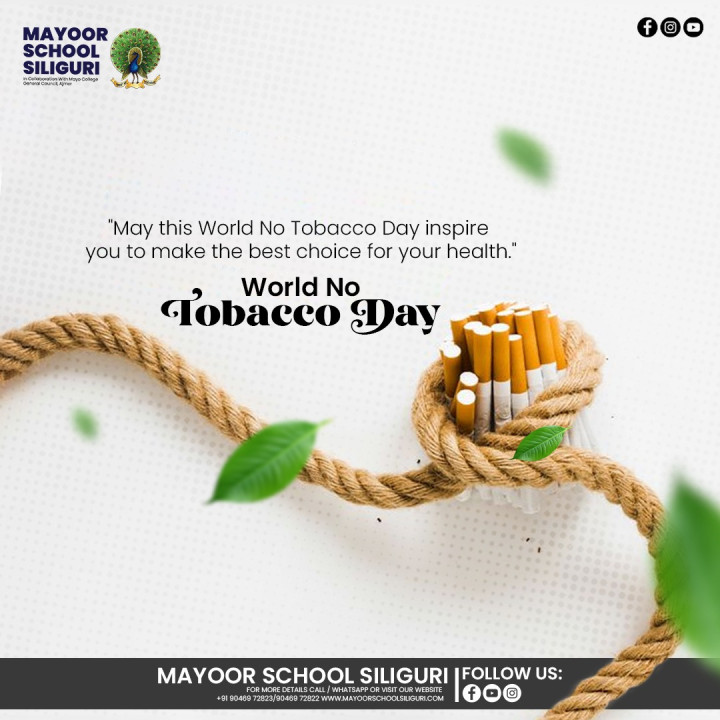
“The Chains of habit are too weak to be felt until they are strong to be broken.” - Samuel Johnson Every puff from a cigarette is not just a fleeting release of stress or a casual indulgence; it is a quiet declaration of war against the human body. Tobacco, cloaked in glamour, rebellion, and social prestige for decades, has long enjoyed a dangerous romance with popular culture. From old Hollywood films to modern-day influencer reels, tobacco’s image has been curated meticulously, masking the ugly truth beneath a thick smog of myths. This World No Tobacco Day, let’s peel back the smoky veil and confront the myths that keep this deadly habit alive. Myth 1: “Smoking makes you look cool.” This is perhaps the most enduring myth, cleverly seeded by decades of marketing. The Marlboro Man. James Dean. Audrey Hepburn. All immortalized with a cigarette in hand. But behind that image lies manipulation. As Robert Proctor, a Stanford historian and author of Golden Holocaust, notes, “The cigarette industry is perhaps the most sophisticated example of corporate manipulation of science and public opinion.” What we perceive as “cool” is often a calculated illusion. Today, we know better. Lung cancer, chronic bronchitis, premature aging, and yellowed teeth aren’t exactly runway material. The World Health Organization (WHO) affirms that smoking causes 8 million deaths every year, a number that hardly sounds chic. “Smoking kills. If you’re killed, you’ve lost a very important part of your life.” – Brooke Shields Myth 2: “I only smoke socially I’m not addicted.” The myth of the “casual smoker” is perhaps the most deceiving. While some believe occasional smoking poses little risk, nicotine has a powerful grip, even infrequent use can lead to dependency. Dr. Nora Volkow, director of the National Institute on Drug Abuse (NIDA), explains: “Nicotine is as addictive as heroin or cocaine… Even people who believe they are social smokers often underestimate how quickly they become dependent.” The Journal of Adolescent Health reports that even smoking one to two cigarettes per week can increase the risk of full-blown addiction in adolescents. Social smoking is not safe smoking, it’s the gateway, not the exception. Myth 3: “E-cigarettes are a safe alternative.” Enter the age of vaping and e-cigarettes, promoted with sweet flavors and slick gadgets. While marketed as “harm-reduction” tools, they’re far from harmless. Public Health England does acknowledge that vapes are less harmful than traditional cigarettes, but “less harmful” doesn’t mean “safe.” The CDC warns that vaping can cause lung injuries, known as EVALI (E-cigarette or Vaping product use-Associated Lung Injury), particularly when users inhale oils or THC-based products. Moreover, the long-term effects of e-cigarettes are still unknown. What we do know is that nicotine exposure in adolescents can harm brain development and increase susceptibility to other addictions. “The true face of smoking is disease, death, and horror, not the glamour and sophistication the pushers in the tobacco industry try to portray.” – David Byrne Myth 4: “It’s my body, my choice.” True, autonomy is sacred. But choices must be informed. Tobacco doesn’t just affect the smoker, it impacts everyone around them. Secondhand smoke causes over 1.2 million deaths annually, as per WHO. Pregnant women exposed to smoke risk miscarriages and birth defects. Children exposed to household smoke are more prone to asthma, sudden infant death syndrome (SIDS), and developmental delays. This is not a solitary habit; it’s a public health crisis. “Secondhand smoke kills. There is no safe level of exposure.” – U.S. Surgeon General Myth 5: “It’s too late for me to quit now.” This is the myth that disempowers. Yet, science paints a far more hopeful picture. The American Cancer Society states that: • Within 20 minutes of quitting, heart rate and blood pressure drop. • Within 12 hours, carbon monoxide levels in the blood normalize. • Within 1 year, the risk of heart disease is half that of a smoker. • Within 10 years, the lung cancer death rate is about half that of a current smoker. It is never too late. Each cigarette not smoked is a battle won. “Quitting smoking is the easiest thing in the world. I’ve done it dozens of times.” – Mark Twain (Ironically true, but also a call for persistence.) Tobacco is not a choice. It is a chemically engineered addiction, protected by marketing myths and socio-cultural norms. We must challenge the narrative, especially among the youth, who are often seduced by flavored vapes and influencer culture. The WHO’s 2025 theme, “Protecting Children from Tobacco Industry Interference,” reminds us of a troubling truth: the tobacco industry continues to target young minds to sustain its profits. Behind every cigarette is a story—a story often written in denial, pain, and loss. But it doesn’t have to end that way. Let’s replace the smoke screen with clarity. With truth. With health. And most importantly, with hope. At Mayoor School Siliguri, a top CBSE school in Siliguri, we are dedicated to shaping responsible, aware citizens. As one of the leading schools promoting tobacco-free campuses, we prioritize health education, strong values, and safe learning environments for every child. “The best time to quit was yesterday. The second-best time is today.”